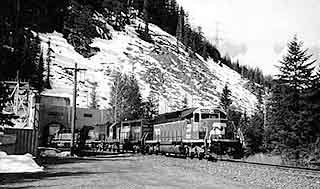|
Subscribe / Renew |
|
|
Contact Us |
|
| ► Subscribe to our Free Weekly Newsletter | |
| home | Welcome, sign in or click here to subscribe. | login |
This Century's Top Ten Construction Projects
|
|
Cascade Tunnel bores a rock-solid spot in history
Dates: 1925-1928
Stevens Pass is a favorite route for cross-state travelers, and a popular destination for skiers and hikers as well. But perhaps few people today realize that 74 years ago the pass was the scene of a herculean engineering effort -- one that ultimately sent trains rumbling through solid rock 1,000 feet below the chairlifts.
Built for the Great Northern Rail way by A. Guthrie & Co. of St. Paul, Minn., the tunnel replaced a shorter one further north. That original Cascade Tunnel, some 500 feet higher than its replacement, was an ongoing expense to the railroad be cause of its switchback approaches and the danger of avalanches. In taking on the new job Guthrie had to meet a number of challenges, both in engineering and from the railroad itself. For starters, the contractor had to complete the tunnel in three years -- an unheard-of feat -- and do it for expenses plus a flat fee. Then, the tunnel had to descend from east to west at a 1.6 percent grade. This made it likely that sub stantial flows of groundwater would gush out, carrying with them the potential for serious delays.
Guthrie rose to the occasion. The project was divided into segments, starting with drilling a 622-foot vertical shaft at a site 2.4 miles west of Berne. The shaft intersected the tunnel route, and provided two additional rock faces for drilling crews to attack. At the same time, engineers pushed a small work tunnel east to meet this shaft. It ran parallel to, but 60 feet south of, the main bore. From it, some 21 connecting passages were cut to the main route, providing 42 more working faces. The work tunnel had many other uses. It carried workers, materials, air pipes and power lines in, and drained 9,000 gallons of water out every minute. Workers attacked the rock 24 hours a day, seven days a week for 35 months. When they were finished, on Dec. 24, 1928, some 923,000 cubic yards of rock and earth had been removed. The project cost $25.6 million, including tunnel construction, relocating the rail line and expand ing electrification. Electric locomotives were used in the tunnel to avoid smoke.
 djc home | top | special issues index
|


